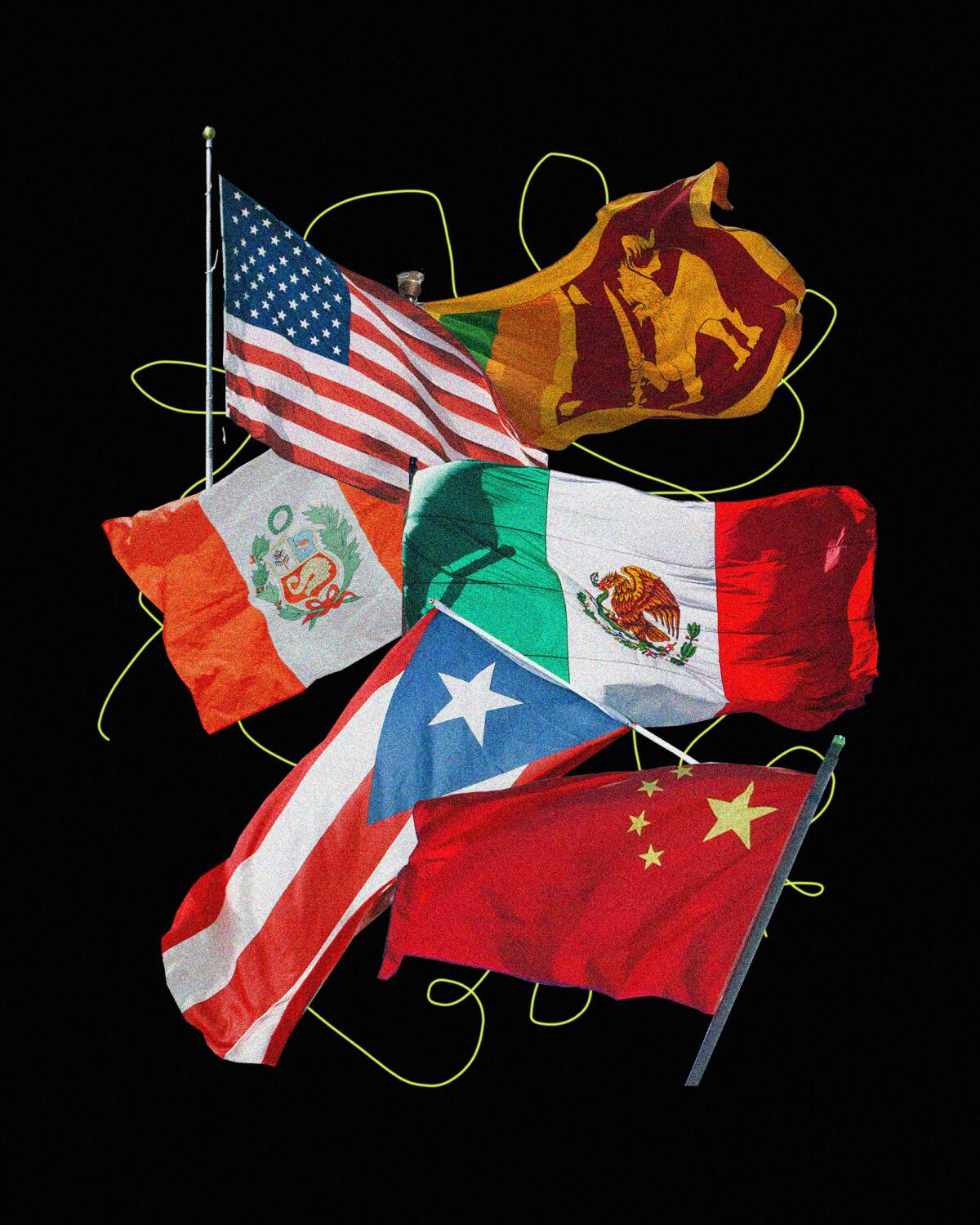AAPI Latinx population in the U.S. has doubled in the last two decades, new study finds

Periodically, the Latinx Files will feature a guest writer. This week, we’ve asked De Los reporter Andrea Flores to fill in.
When Kevin Kandamby introduces himself, it’s never in halves.
“I’m fully Mexican and fully Sri Lankan,” he said.
Both his mother and father— immigrants from Mexico and Sri Lanka, respectively — ensured that both cultures were present in their household. Kandamby, who self-describes as “MexiLankan,” never had to choose between Catholicism or Buddhism, frijoles or dal. Both could co-exist.
“I’m not half of something, I’m actually double,” he said.
Kandamby is one of the more than 886,000 individuals living in the United States who identify as Asian and Pacific Islander, and Latinx — a figure that has increased twofold from 2000 to 2022, according to a new analysis by the UCLA Latino Policy and Politics Institute (LPPI).
The study is a joint effort between the AAPI Civic Engagement Fund and LPPI’s Latino Data Hub, and draws from the 2022 five-year American Community Survey.
You’re reading Latinx Files
Fidel Martinez delves into the latest stories that capture the multitudes within the American Latinx community.
You may occasionally receive promotional content from the Los Angeles Times.
Kandamby, who is co-author of the report, hopes the growing figures will paint a broader picture of what AAPI Latinx identity can look like.
“Latinidad is a broad spectrum,” he said, adding that “we need to center the voices that are often thrown to the margins.”
California is home to 302,000 AAPI Latinxs, accounting for more than a third of the group’s nationwide population. According to the analysis, nearly half of all AAPI Latinxs are under the age of 18 and only 5% are noncitizens — a much lower rate than the Latinx (19%) and AAPI (26%) populations.
The study’s findings are in line with what The Times reported in May 2022 in an article written by Brittny Mejia, Anh Do and Sandhya Kambhampatithis. Their story highlighted the complexities of navigating two cultures, and oftentimes two languages.
As a PhD student at UCLA, Kandamby has focused on championing AAPI Latinx identity — he’s currently working on a photo project that will showcase diversity within the community.
“It’s important for people to understand that what it means to be an AAPI Latino is completely different for everybody,” he said.
Though the study highlights the rapid growth of the demographic, AAPI Latinxs have existed for centuries, says UCLA professor Robert Chao Romero. He points out how Mexico and the Philippines were connected via the Manila Galleon trade routes, which were used by Spanish merchants from 1565 to 1815. Romero estimates that up to 100,000 Asians and Pacific Islanders migrated to Latin America during this colonial period, including an estimated 8,100 enslaved Filipinxs who came to Mexico.
By the late 19th century, anti-Asian hysteria swept the U.S., leading to the passage of the 1882 Chinese Exclusion Act. Romero says that the law gave birth to illegal migration in the country.
“Many Chinese migrated to Mexico and Cuba because they were excluded from the U.S.,” Romero said. “The Chinese developed a whole international smuggling network and mechanisms of undocumented immigration that we associate with Mexico today.”
Other Chinese migrants settled in Mexico, becoming successful small merchants in the process. “Unfortunately, in Mexico, there was an anti-Chinese movement as well,” Romero said, highlighting the Torreón massacre, where 300 Chinese nationals were murdered.
Romero points out that AAPI Latinx history often exists at the crossroads of colonization, labor and immigration.
In the 1850s, hundreds of Chinese laborers were contracted to help build Panama’s railroad system. In 1899, Japanese agricultural farmers aboard the Sakura Maru ship arrived in Peru — the first Latin American country to establish diplomatic relations in Asia — giving birth to an entirely unique diaspora. In 1900, the U.S. brought an influx of Puerto Rican sugarcane workers to Hawaii, a year after acquiring both territories.
Consider subscribing to the Los Angeles Times
Your support helps us deliver the news that matters most. Become a subscriber.
The UCLA Latino Policy and Politics Institute report reflects these histories — Panamanians, Puerto Ricans and Peruvians are the Latin American groups most likely to self-identify as AAPI.
Romero, who is of Chinese and Mexican descent, believes that understanding these bonds can enhance political, social and economic ties among Latinx and AAPI communities.
“What we are seeing today [in the U.S.] is a modern expression of historical interactions driven by immigration laws and economics,” he said. “Coalition building is critical, especially in California where the two fastest growing ethnic groups are Latinos and Asian.”
— Andrea Flores

Things we read this week that we think you should read
8 movies to watch at this year’s Los Angeles Latino International Film Festival
The Los Angeles Latino International Film Festival kicked off Wednesday. Planning to attend but don’t know what to watch? De Los contributor Carlos Aguilar compiled a list of eight unmissable movies to check out at LALIFF 2024.
Shhhh. The Silver Lake Reading Club has started
Every Tuesday night, dozens of avid readers pay $17 for two hours of peace and quiet inside Lamill Coffee in Silver Lake. Staff writer Thomas Curwen has more on the Silver Lake Reading Club, a silent reading group that helps attendees shut out the outside world so they can be consumed by their books.
Column: The Democratic civil war behind an Anaheim recall election
Anaheim Councilmember Natalie Rubalcava is facing a recall election 18 months after being elected. Critics of Rubalcava accuse her of acting as a corporate puppet belonging to one of Anaheim’s “cabals.” The first-time politician discusses with columnist Gustavo Arellano the tensions within the recall and how it is affecting Anaheim Democrats.
Honoring Skid Row as a home to artists, activists, community
Last week, the Los Angeles Department of Poverty held its biennial parade, Walk the Talk. The celebration commemorates the Skid Row community and highlights the neighborhood’s artists and activists. Staff writer Julissa James spent some time getting to know some of the parade’s participants, the work they make and the services they provide for the community.
Bullets before ballots: Dozens of Mexican candidates have been killed as cartels seek more control
At least 30 political candidates have been killed ahead of Mexico’s upcoming June 2 election, the country’s biggest vote to date with more than 20,000 posts up for grabs. Times foreign correspondent Patrick J. McDonnell reports on the unrest facing Mexico, where cartels are looking to expand their control in states where they already have political sway.
Where does L.A.’s leftover produce go? This group helps get tons to the hungry every day
In an effort to minimize food waste, nonprofit Food Forward is focusing on redistributing produce all over Southern California., moving more than 125 tons of food daily. Staff writer Jeanette Marantos has more on the organization, which coordinates with other groups to ensure the produce is being sent to where it is most needed.
—Cerys Davies
The Latinx experience chronicled
Get the Latinx Files newsletter for stories that capture the multitudes within our communities.
You may occasionally receive promotional content from the Los Angeles Times.





